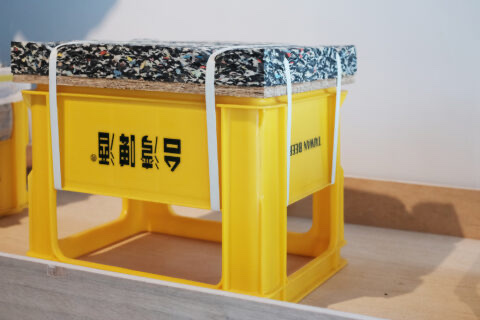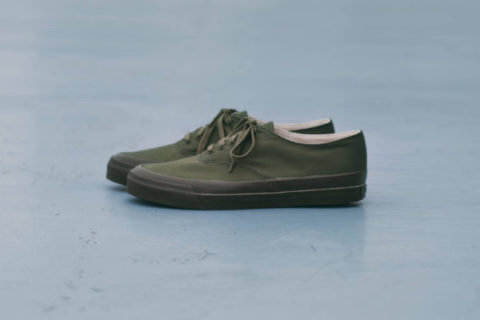
Tiffanie Turner造的紙花卉,盛開得燦燦爛爛,它芳華正茂,卻也徐徐老去——好幾片花瓣早已泛黃,無聲無息地枯萎。青春是美,蒼老也美。Tiffanie說她並不是首個表現花卉在各個階段的美感的藝術家,萬物皆有時,花卉自古以來都是時光荏苒,生命無常的象徵。但她並不打算讓它象徵任何東西,她只要它們是花,自在而美麗。
The paper flowers made by Tiffanie Turner are blossoming, in fact, they are blooming and withering at the same time, for some petals have silently lost their vivid color. The definition of beauty is fluid, it can be the beauty of youth, or the beauty of aging. Turner said she’s not the first artist who works on the charm of different stages of a flower’s life. Everything has its own cycle; the short life cycle of flowers has always been one of the essential signifiers of the unpredictability of life. To Turner, flower is not a medium for her to convey any grandeur message, all she wants to portray is the contented beauty of flowers, no more, and no less.
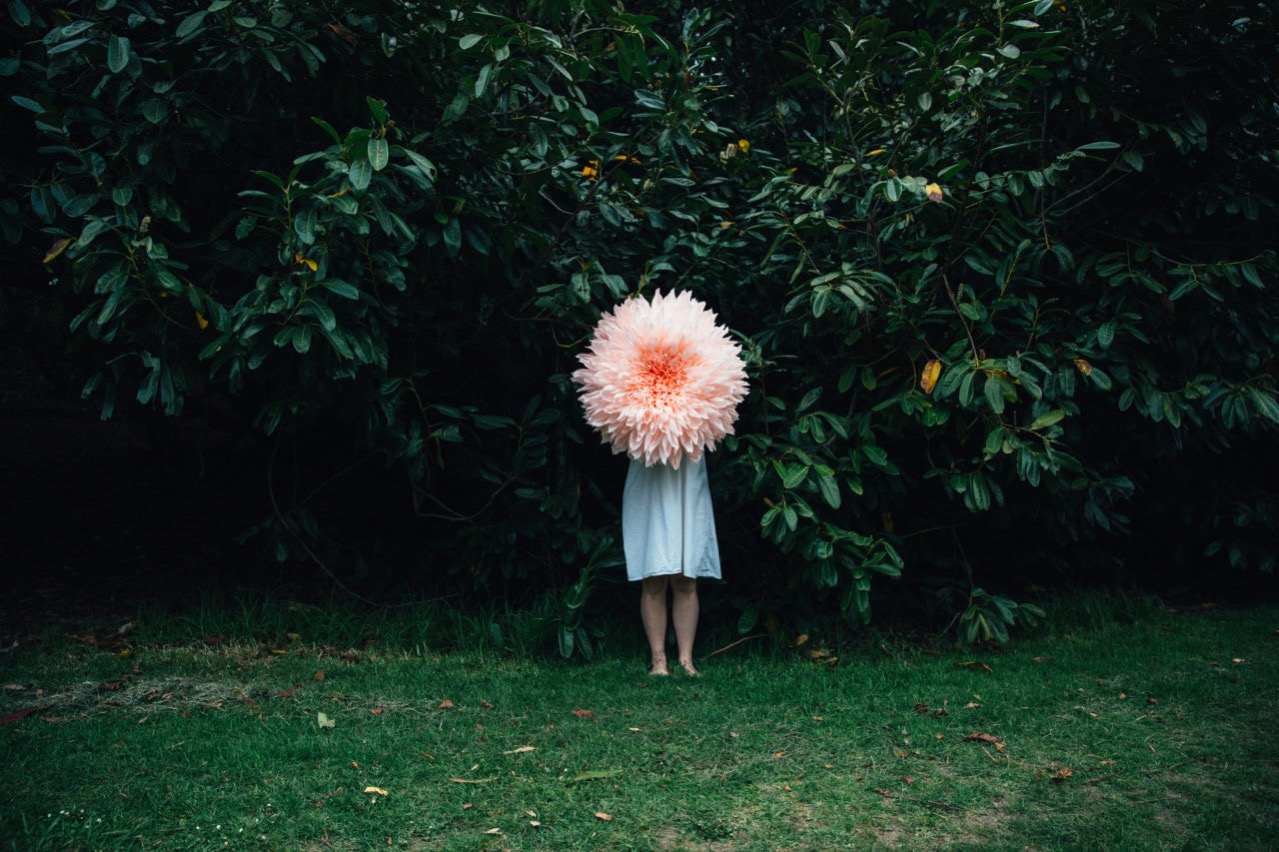 photo by Sarah Deragon
photo by Sarah Deragon
R:是甚麼驅使你由建築師轉行為植物雕塑家呢?
T:在我第二個孩子出生以後,我決定暫時退下建築師的工作好陪伴孩子。某天我在造衣服,需要一些花朵作頭飾,在網上卻找不到耐用的。所以便訂了些皺紋紙,開始實驗,並且在網上分享我的作品。後來我獲得機會教授紙花卉製作,在我造大花時,則得到機會舉行較大型的展覽。所有事情像滾書雪球一樣,於短時間之內發生,超越了我的預計。
R:為甚麼你選擇以紙作為主要素材呢?
T:我最初會想製作紙花卉,其實是因為紙張本身呢。它們太美了!我使用來自意大利、中國及德國的皺紋紙,紙張的顏色都很不可思議。很少職業是讓你在日常生活中接觸這些色彩的。皺紋紙很適合用來造紙花,它單薄而且能演化出不用的形態。
R:You were once an architect, what made you leave the field to become a botanical sculptor?
T:After the birth of my second child, I took some time off from my solo career as an architect to be with the children. One day during this time I was making a costume and needed some flowers for the headdress, so I looked online, but didn’t see anything that seemed durable enough. So I ordered some crepe paper and started experimenting, and then started sharing my work online. This turned into chances to teach what I knew, and when I started making the larger flowers, it turned into chances to do large exhibits. It snowballed into something over a very short time that I never could have predicted.
R: Why did you choose paper, instead of other materials, as your medium?
T:Part of the reason I became hooked on paper flower making was the paper itself, it’s so beautiful! I use crepe paper from Italy, China and Germany, and the colors these papers come in are extraordinary. There are few professions in life where you are in contact with these types of colors on a daily basis. Crepe paper lends itself to paper flowers, as it is thin and can be shaped in many ways. If I had fallen in love with a different material, it is possible I might not be making paper flowers at all!
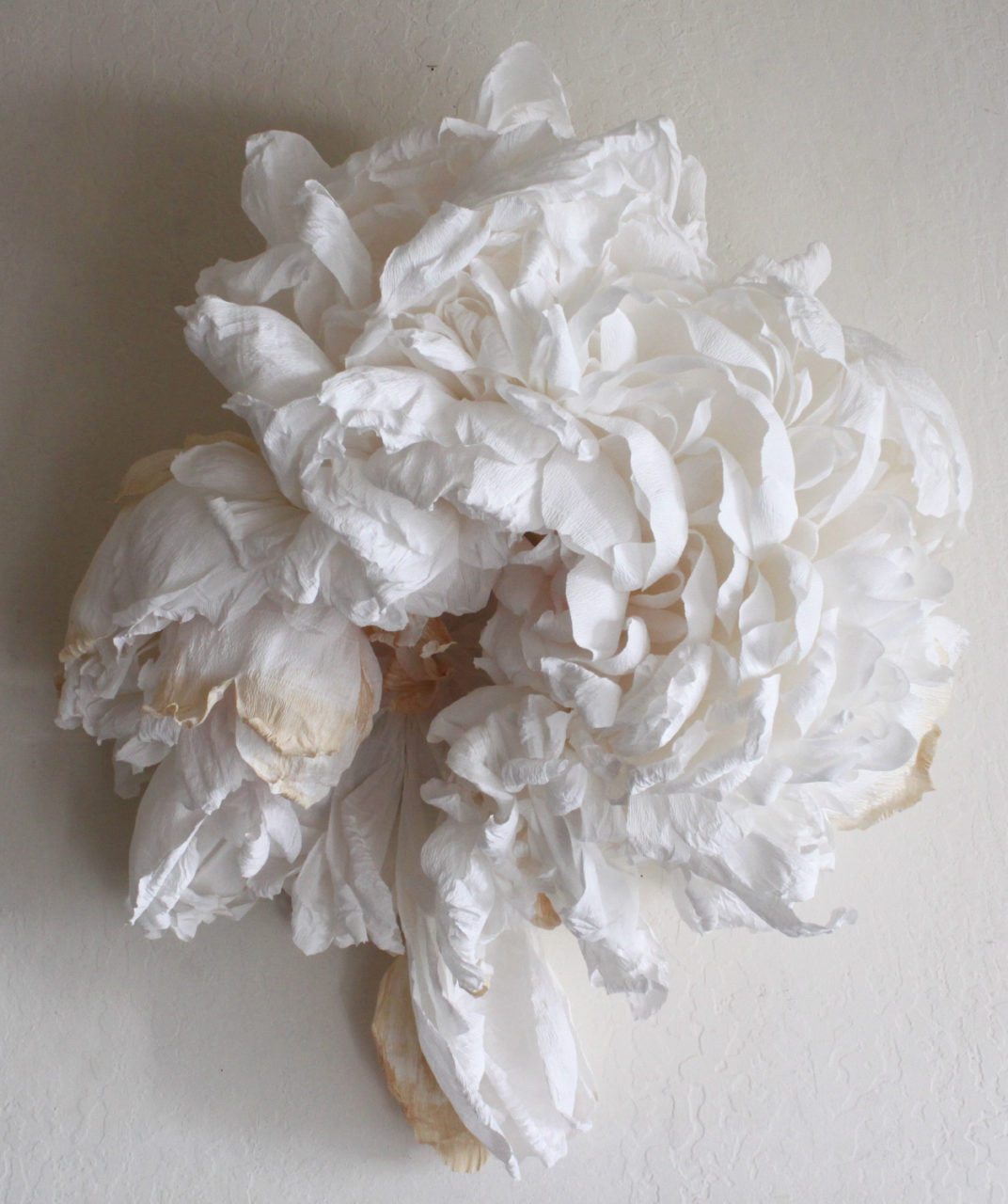
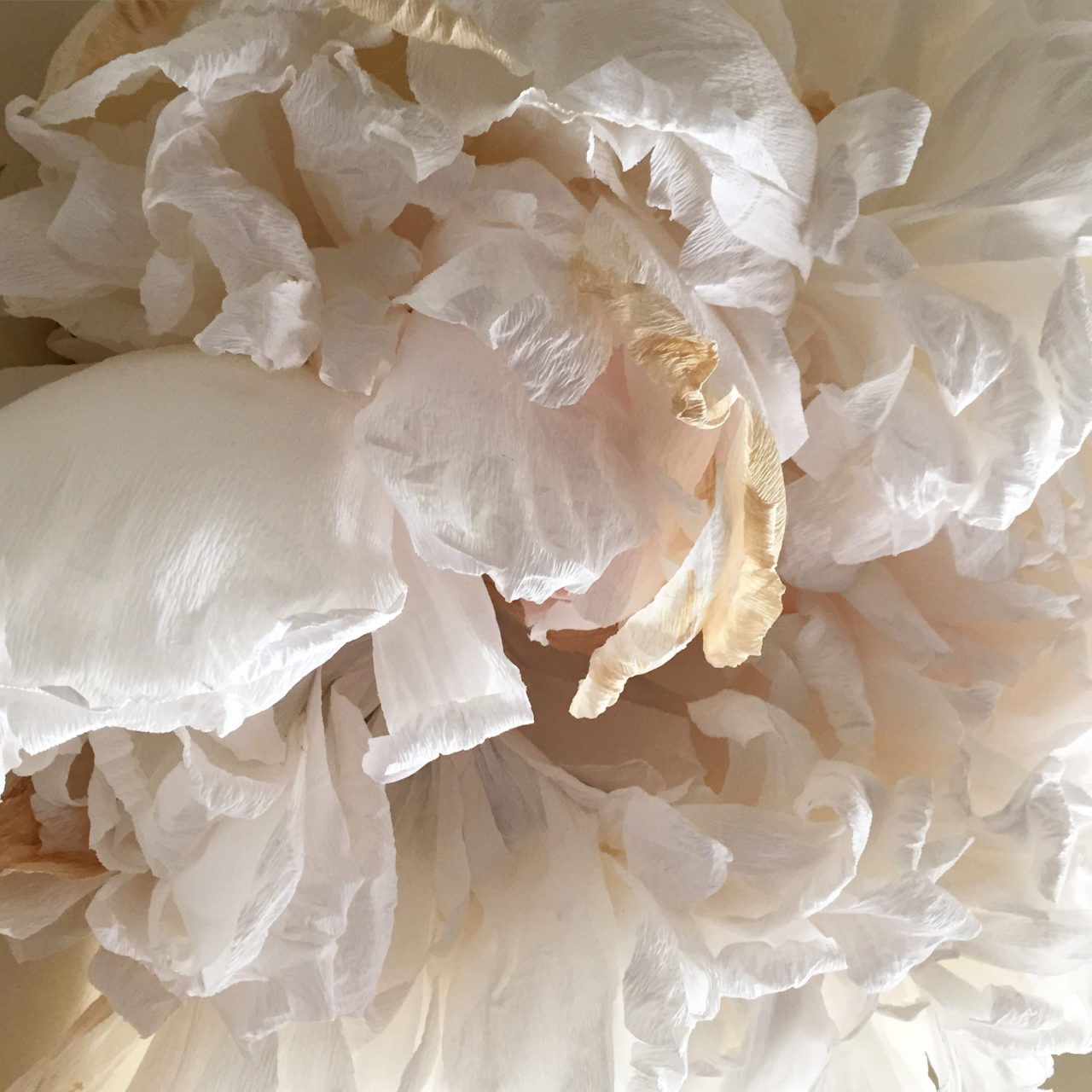
photo by Tiffanie Turner
R:你是如何開始學習製作紙花的呢?
T:我是自學的。我猜自己之所以能如此快上手,是因為我很愛手造東西。我在建築公司就職時,晚上常兼職造建築模型,製作花卉可說是這工作的演化。剪裁、黏貼、計算比例,這些工序都是相通的。
R:你造的花卉看來非常真實,可以談談你在創造前的研究過程嗎?
T:我花了很長的時間看書、上網,並到花店找尋藍本。我會在作品中展現自己眼裡所見的,而非單憑記憶。我會用紙來模臨它,嘗試用不同的方法,直接達到自己的要求。八月時我出版了書籍《The Fine Art of Paper Flowers》,展示了我創作紙花卉時的秘密。
R:How did you learn making the paper sculpture?
T:I am self-taught. I think I took to it easily because I’ve always loved working with my hands. At the last architectural firm I worked for, I made cardboard and chipboard architectural models at night for extra money. I think that type of work parlayed itself into the flowers. Cutting, glueing, working with scale, it’s all part of it.
R:The flowers you made look very real. Can you tell us how do you conduct the research in the flowers and get the shape you want?
T:I spend countless hours looking at books, online, and going to the florist’s shop to find my specimens. If I need something in particular, I’ll ask the florist to look for it at the flower market for me. The realistic shapes and forms I get come from studying the flower and trying to create exactly what I see, not just what I think I remember that flower to look like. I can stretch the paper and manipulate it in many ways to get it to do what I want. I share all of my secrets to how I make paper flowers in my book, The Fine Art of Paper Flowers, which comes out on August.
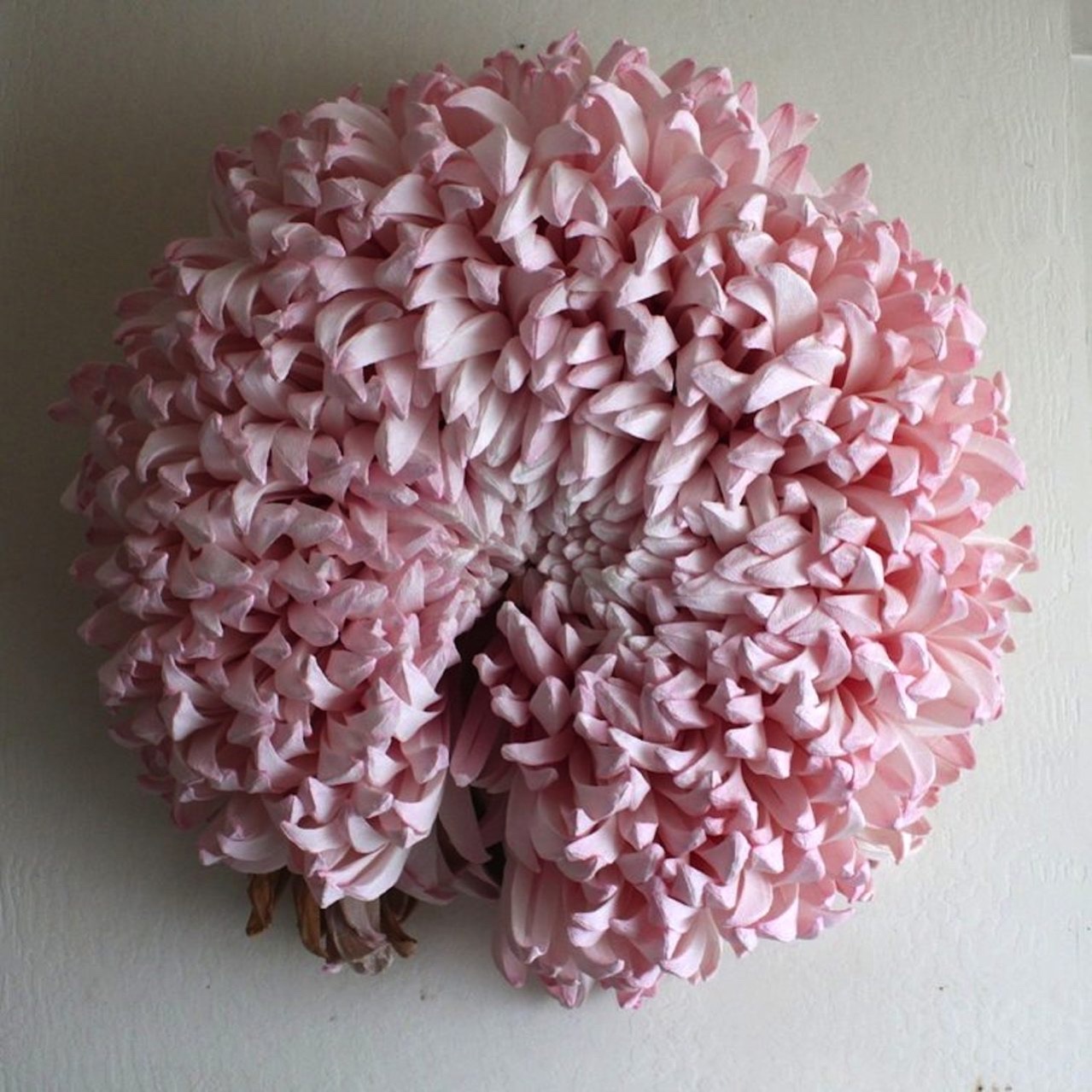
photo by Sarah Deragon
R:你是從甚麼時候開始喜歡花卉的呢?你有自己種植植物嗎?
T:我成長於美國東部,一個森林裡。從小我就很喜歡大自然了:樹、湖泊、沙、青苔⋯⋯它們填滿了我的生活。但花卉對我來說是更具設計感的,它們有著所有我需要的元素:圖案、質感及顏色。當我在建築學校時,透過繪畫,我開始認真研究他們,這些年來,越來越被它們深深吸引了。
很可惜在三藩市的家裡沒有庭園,而且很可惜我是一個家居植物殺手。我們正計劃數年後便離開三藩市,而我們移居的地方將會在大自然裡,有空時我會建立一個英式花園,這是我的計劃。
R:我很喜歡你那輯人與花卉的造形照,可以談談它的靈感來源嗎?
T:2014年,當我要為首個展覽 HEADS 製作宣傳品時,我在腦中描劃了一個夢幻的場景——在田野內、樹林間,我穿著白色的裙子,並將一朵巨大的粉紅花卉置在面前。我後來邀請了攝影師Sarah Deragon實現這想法。我們在清晨時份來到三藩市的Golden Gate Park,在寒冷而滿是濕氣的公園了,我們進行拍攝。現時,於完成每件作品時,我仍會拍攝意念相近的作品,並嘗試給予每幀照片一些小故事。不過近來我發現了很多模仿品,於是我沒有再堅持拍攝了,除非某個時刻打動了我。
R:When did you love for flower begin? Do you also do gardening?
T:I grew up on the east coast of the United States, in the forest. I have always loved nature: trees, lakes, sand, moss. They are my lifeblood. But flowers appeal to me on a more graphic, visual level. They contain everything I need as far as patterns and textures and colors. I really started to study them through painting as a hobby, when I was in architecture school years and years ago, and became more and more obsessed with them over the years.
Unfortunately, I do not have a garden here in San Francisco, and I have a “black thumb” when it comes to house plants. But we plan on leaving San Francisco in a few years, and wherever we land, it will be in nature, and I will make up for lost time by creating a giant English garden. That is my plan, anyway.
R:I like the photos in which you put a huge flower in front of your face. How did you get that photo shooting idea?
T:I created a dreamlike scenario in my head to use to promote my first solo show, “HEADS”, in 2014. I pictured myself in a white dress floating around a field and in the trees with a giant pink flower in front of my face, and hired photographer Sarah Deragon to help me make this vision a reality. We went out into Golden Gate Park in San Francisco in the very early morning, when it was still misty and cold, and took the photographs. I continued to do it each time I completed a piece, always trying to give the photograph a little story. It is now being duplicated and imitated by so many people around the world that I have pulled back from doing it with every flower, instead only doing it if the moment strikes me.
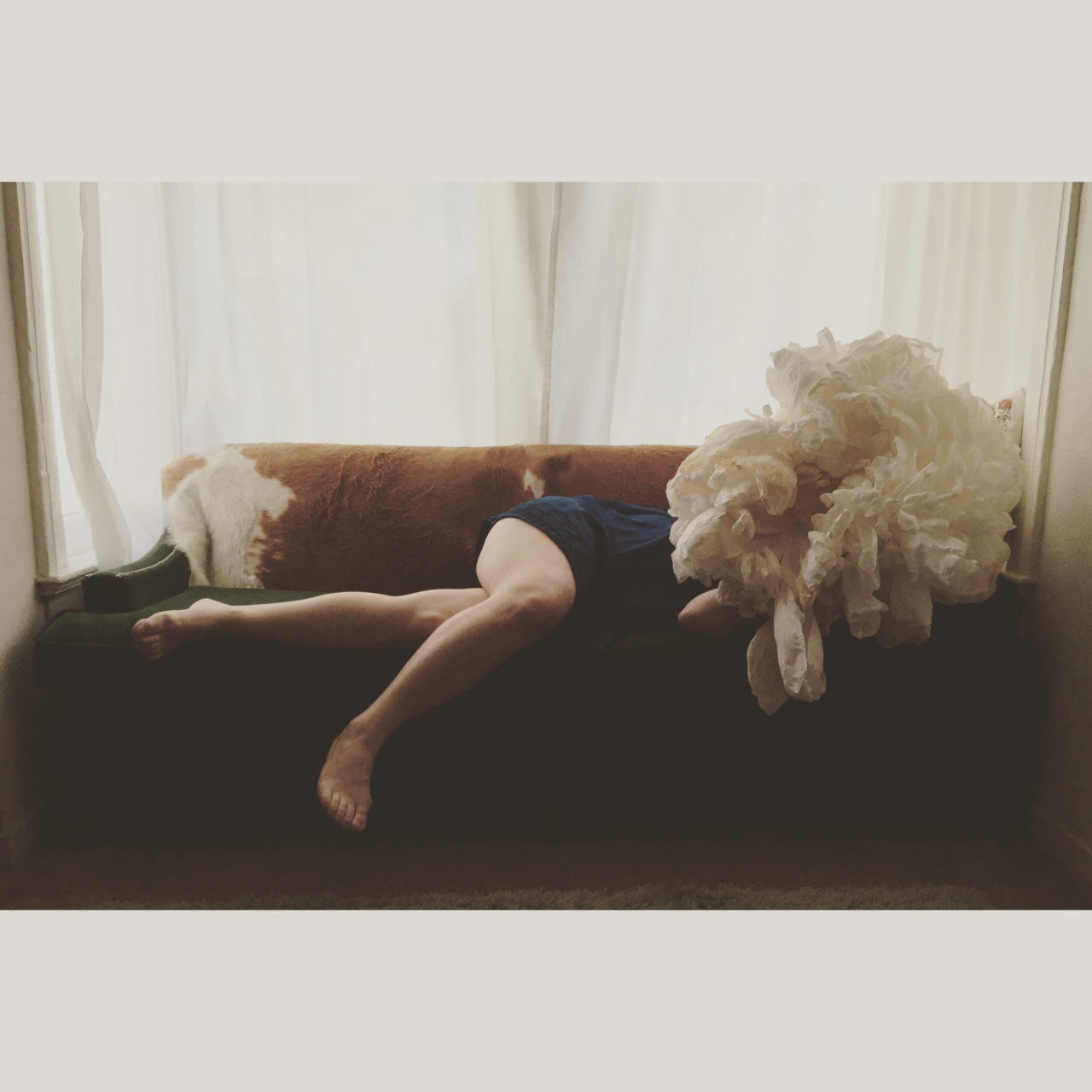
photo by Stella Vazquez
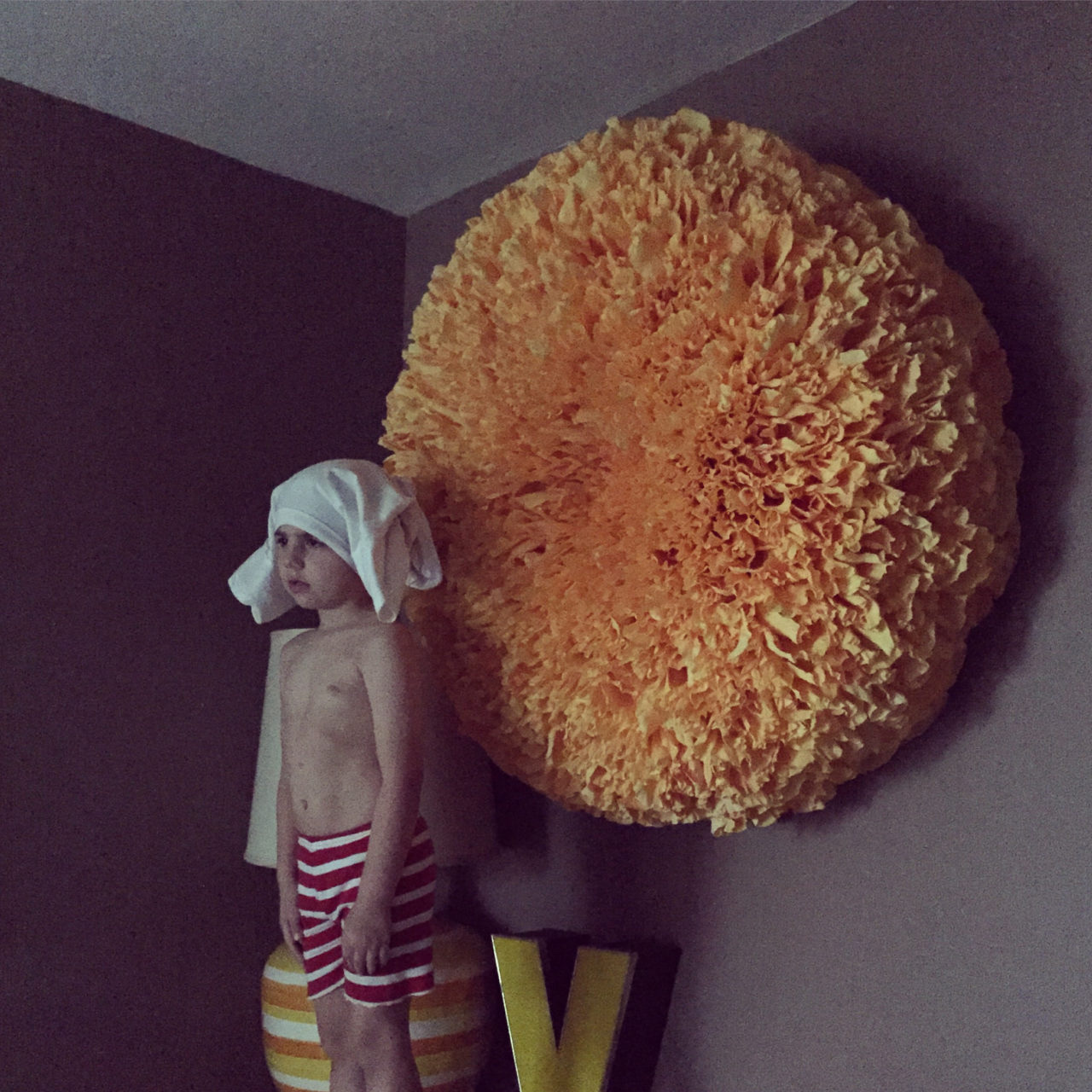
Phoro by Tiffanie Turner
R:你所製作的花卉,不少都是在開始枯萎的狀態的。可以談談你怎看花卉的美嗎?
T:我並不是首個發現植物枯萎時的美感的人呢。在很多年前,不少畫家及雕塑家,便以植物及花卉作為生命短暫與無常的象徵,他們以此來探究死亡。花卉步向死亡時,有些花瓣會開得特別燦爛,有些則隱藏起來。花卉容許我將這些部分都展示出來,容許我將其萎靡的過程呈現出來。我非常喜歡這工作。
R:世界上那麼多花卉,你如何決定要製作哪一種呢?
T:有時我的選擇標準在於,它們是否適合以紙來表達呢?在我將之形態變得抽象,將它原來的花瓣數目增加數百倍,質感及顏色都不同了,是否還能看出它原是哪一種花。有時我的選擇是沒有任何標準的,只是深被它們牽動而已。
R:I found it is very interesting that your works do not merely show the most “beautiful” face of the flower. Sometimes dried petal can be seen in your work. Can you tell me how do you see the beauty of flower?
T:I am not the first to find beauty in faded and wilting botany. There are many painters and sculptors from centuries ago who explored death in their works as a symbol of the temporality and impermanence of human life. When a flower dies, it opens up to reveal parts that may have otherwise been hidden. It allows me to show those parts, and also gives me so much artistic license, allowing me to express the way or amount the flower is decomposing. I enjoy this work immensely.
R:There are so many types of flowers in the world. How did you decide base on which flowers to create your works?
T:Because my botanical sculptures can be made up of thousands of petals, and take up to six weeks of dedicated time to complete, there is a huge time commitment. I end up with a giant backlog of ideas: specimens, techniques, textures, colors, and experiments sitting in my head, waiting for me to try them. I always know what I am going to create next, because I have so much time to think about it while working on piece that comes before it. I select the flowers based on how well I think it will translate in paper, whether I can make an abstraction from it that still reads like the flower, even if it has hundreds of times the amount of petals it would normally have, and what the texture and color are. And then some flowers just appeal to me to my core, without much explanation!
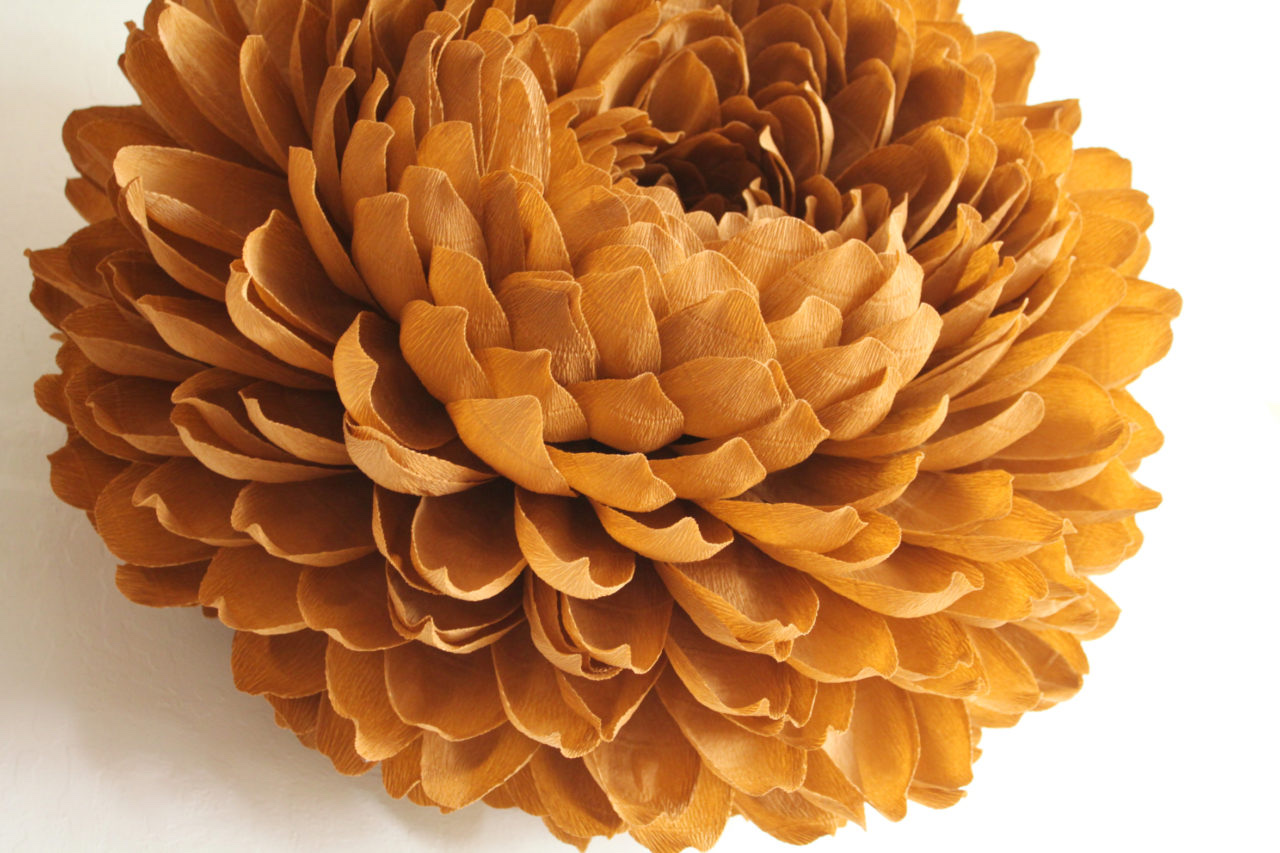
photo by Sarah Deragon
R:談談花卉製作的困難與樂起吧。
T:最大的困難是,每次製作一朵花,我便得花上四至六星期,專注於創作。我的家人受罪、我的家受罪、我的健康受罪。我的靈魂都歸於花卉了,精神都被抽乾了。最有趣的是,我可以學習到一朵花,我花時間製作每片花瓣,並考慮如何將之添加在一朵花之內,過程中我便與花的關係,變得越來越深切了。
R:你在自我介紹中提到Tom Friedman 及 Lee Bontecou,可以談談這兩位藝術對你的影響嗎?
T:Tom Friedman 常使用相近的元素,方糖、口香糖、牙籤,有時還會用色紙來製作雕塑。我在1990時於紐約看過他的作品,並深受影響。我漸被有著重覆的元素的、歷久的東西所吸引。這對我來說別具意義。
Lee Bontecou的作品是非常有機的。她的作品很出色,且常常看似歷盡風霜。她使用物料的方式不拘一格,我也相樣。我讀到一篇文章,談到她如此捨棄了學院派的藝術世界,而走向田園,這聽起來很美好,著實是一個很誘人的主意。
R:What is the most interesting and most challenging part of making botanical sculpture?T:The most difficult part for me is the absolute exhaustion I experience when working on one. It takes all of my time and focus for the 4-6 weeks I will spend on one. My family suffers, my home suffers, and my health suffers. My whole soul goes into these flower, and it is incredibly draining. The most interesting part is learning so much about one flower. The amount of time I have to consider each petal and how it fits into the flower with all the others provides me with a a deeply intimate relationship with the flower.
R:You mentioned about Tom Friedman and Lee Bontecou in your profile, would you tell me how they have influenced you?
T:Tom Friedman works with repetitive elements like sugar cubes, chewing gum, and toothpicks, and sometimes even construction paper to create his large sculptures. I saw his work in person in the early 1990 in New York City, and it had a deep effect on me. I am drawn to anything that has repetitive elements and takes a lot of time. That process is something that means a lot to me, and I admire greatly.
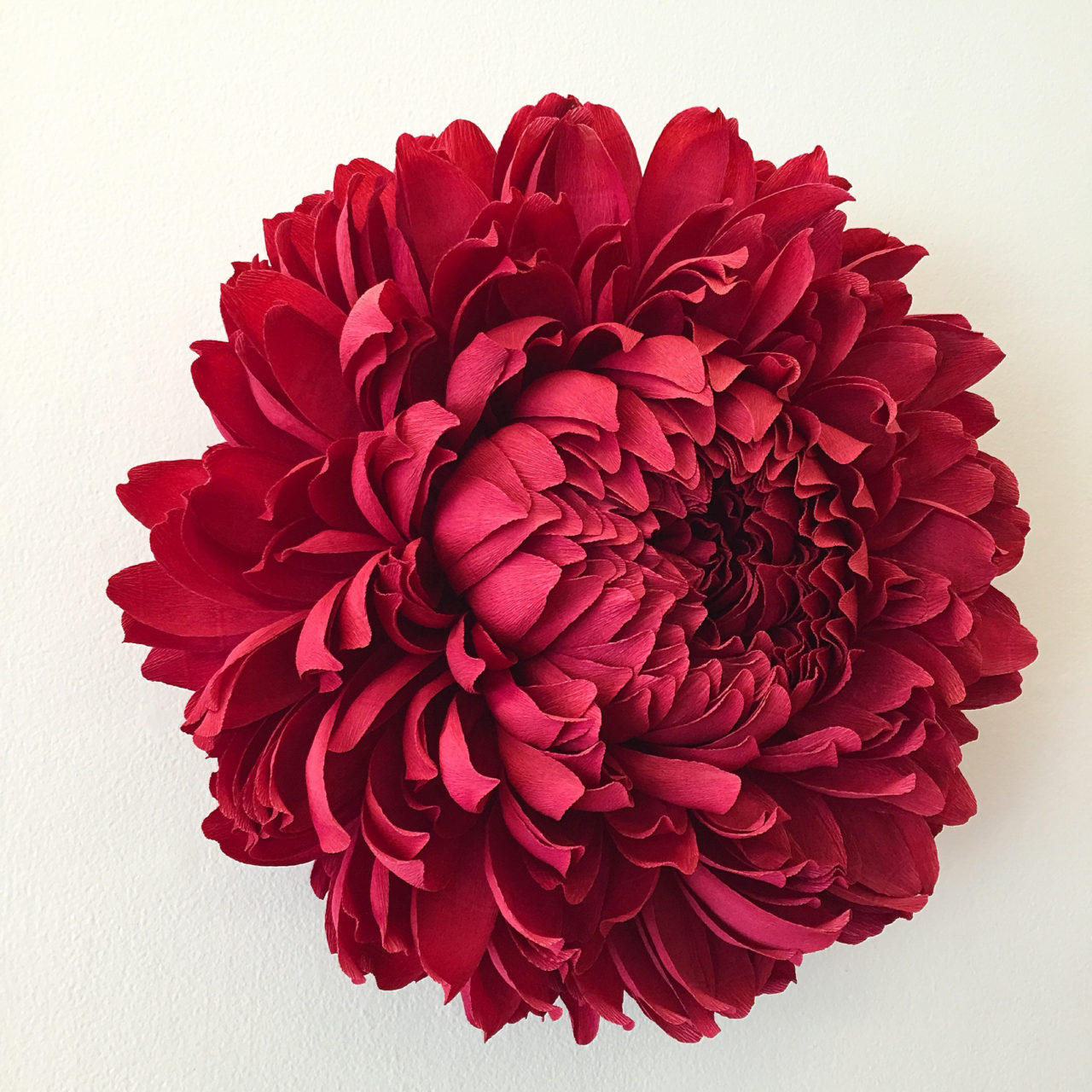
photo by Sarah Deragon

